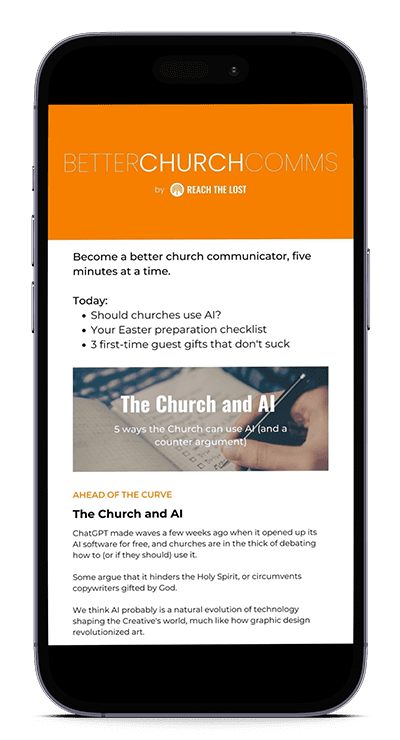Reach the lost
Unpacking Church Attendance Statistics
Reach the lost
Unpacking Church Attendance Statistics
The Church is changing, but it isn’t dying.
The landscape of Christianity in the United States has changed dramatically in the last decades, and the needs of the church are significantly different than they were.
With an apparent decline in church attendance on Sunday morning and an overall decrease in religious affiliation across the board, people need Jesus more than ever.
In order to adapt and thrive, we have to understand how the patterns of church attendance are changing.
36%
fewer Americans attended church weekly in 2020 than in 1993.
48%
of Christians believe people they know are tired of the typical church experience.
57%
of people believe Church has no or even negative impact on communities.
47%
of Americans said they belonged to a church, synagogue or mosque, down from 50% in 2018 and 70% in 1999.
Church Attendance Statistics
How did COVID-19 Affect Church Attendance?
1 in 3 Christians stopped attending church during COVID-19
While this number has fluxtuated since the beginning of the COVID-19 global pandemic, during the height of covid, a third of practicing Christians stopped attending church. Pastors and church leaders may be experiencing pain points in seeing their attendance numbers return to what they were pre-pandemic.
1 in 4 pre-pandemic church-goers are missing
While many regular church attenders have come back after a global pandemic, over 25% of them never came back to in-person church. This comes in opposition to the reported 91% of Christians who said they would come back to in-person church after the pandemic.
40% of Christians have changed their church-attendance habits post-COVID
Roughly 40% of Christians have made a change in the way they attend church since the pandemic. Whether they have changed which church they attend, attend multiple churches, or stopped attending entirely, COVID-19 shook up people’s church attendance routine.
Church membership dropped below 50% during the pandemic, a record low
According to a Gallup study with data going back to the 1940s, church membership hit an all-time low surrounding the covid-19 pandemic. This may correlate to a decrease in churchs with a membership process, decreased trust in the church, and a general decoupling from religious organizations.
1 in 5 regular church attenders only attend virtually
According to study by Pew Research, 31% of regular church goers (that’s people who attend at least once a month) only attended in person. Another 36% of attendees joined church both physically and digitally. And 21% of attendees are still substituting virtual attendance for in person attendance. This can be attributed to the ease of digital engagement, continued health and safety concerns, and the increasing quality of livestreamed services.
Want free church marketing resources delivered to your inbox?
BetterChurchComms is the 5 minute newsletter to a better church communications ministry. Get templates, tools, ideas from other churches, and personal leadership development to keep you in ministry for the long run.

Church Attendance Statistics
How Are People Attending Church?
Church attendance looks drastically different after the pandemic. Does your outreach strategy include reaching the new masses of online attenders?
The Stats
- 33% of church attendees first found their church online. There are over 800,000 people a month googling “churches near me” and an increasing number of people are finding houses of worship through the internet.
- 20% of church-goers attend exclusively online. And another 26% of attenders use a hybrid model of online and in-person church attendance. If you aren’t using a livestream or other online church option, you are missing out on almost half of church-ready people.
- Two out of five church-goers report regularly attending 2 or more churches. While the majority of Christians are still attending just one church, many people, especially millennial, are “church hopping” between different congregations.

Church Attendance by Demographic
Millennial Church Attendance is Up
Pew Research Center has done studies on church attendance by demographic, and unsurprisingly, 48% of boomers claim to be weekly church attenders, compared to 30% of Millennials and GenZ. However, a study by the Barna group suggests that Millennial church attendance is up 22% since COVID, compared with boomers, who saw a slight decline in church attendance.
Gender and Church Attendance
Historically women have attended Christian houses of worship about 10% more than men. But new statistics show that women and men now attend at similar rates, due to a decline in female attendership.
Does race affect church attendance?
In 2021, white and non-white Millennials attended church at the same rate of 18%. But since then, weekly church attendance has risen to 35% among white Millennials, and 45% for non-white Millennials. Race may not affect church attendance, but it’s important to note the increase in attendance.
Gen Z is the Biggest Opportunity for Churches
According to a report by the Survey Center on American Life, Generation Z makes up the highest percentage of religiously unaffiliated people in American history. At a whopping 34%, Gen Z is less religious than previous generations by a large margin. The church has an amazing opportunity now to share the good news of Jesus and capture the hearts and minds of the younger generations.
Adapting Church to a Changing World
Church is changing, and the landscape might feel bleak.
But some churches are finding new opportunities. Multi-sites, online campuses, house churches, and more are enabling churches to reach new people.
Engagement-First Growth Strategies
For years, we’ve focused on driving church attendance up, hoping that it would lead to engagement with groups, ministries, and events. That worked when people generally wanted to attend church. Today, we have to start with engagement, meeting the need for community or mental health resources. The engaged will attend, not the other way around.
If you’re looking for a team to come around you and help you develop a strategy for increasing community awareness and engagement (and even leaning on the Google Ad Grant to do it), we’d love to talk.
Don’t Forget Online
The prevalence on live-streaming has brought the hope of Jesus to the screens of people who would never set foot in your church.
The hurt-by-the-church, the skeptics, the recent divorcee. They aren’t ready to attend your building, but they are watching your sermons.
They aren’t just a number. They aren’t vanity metrics. They’re real people at one step on their journey. Make an engagement and discipleship strategy for them.
Reach People Where They’re At
People don’t go to church because it’s culturally expected anymore. We have to be out in the world, meeting people where they are.
Our partner churches use us to create landing pages for common Google searches in their community, and the Google Grant to get thousands of local clicks a month. You can get this audience connected with your services, ministries, and programs.
There's a lot to do.
We can help.

We're a team with a heart to partner with churches and a system to see churches grow.
We help churches and nonprofits with Google Grant management, SEO work, church website design, and campaign development, all at affordable rates.

Ryan Clark
CEO
I'm a digital marketer with a background in the sports industry, but a heart for the Church. I got into Reach The Lost to see churches thrive in the digital space.

Maddie Hsin
Content Marketing Manager
I'm a sucker for a good story and seeing things grow, and I want to see churches further engage their communities. I'm excited to be developing content that helps churches the needs in their cities.

Mike Ruman
Digital Strategist
I'm a certified Storybrand consultant with a background in a variety of marketing agencies. I'm excited about bringing top-tier strategy to nonprofit and church spaces.



